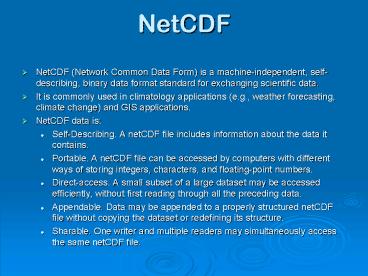NetCDF - PowerPoint PPT Presentation
1 / 8
Title:
NetCDF
Description:
Binaries are free and are available for most common Linux/Unix, Mac OS and Windows. ... CAM-CLM Subroutine Call Tree. GT HTML Version of CAM3.1-CLM3 code see at ... – PowerPoint PPT presentation
Number of Views:86
Avg rating:3.0/5.0
Title: NetCDF
1
NetCDF
- NetCDF (Network Common Data Form) is a
machine-independent, self-describing, binary data
format standard for exchanging scientific data. - It is commonly used in climatology applications
(e.g., weather forecasting, climate change) and
GIS applications. - NetCDF data is
- Self-Describing. A netCDF file includes
information about the data it contains. - Portable. A netCDF file can be accessed by
computers with different ways of storing
integers, characters, and floating-point numbers. - Direct-access. A small subset of a large dataset
may be accessed efficiently, without first
reading through all the preceding data. - Appendable. Data may be appended to a properly
structured netCDF file without copying the
dataset or redefining its structure. - Sharable. One writer and multiple readers may
simultaneously access the same netCDF file.
2
NCDUMP
- ncdump generates an ASCII representation of a
specified netCDF file on standard output. The
ASCII representation is in a form called CDL
(network Common Data form Language) - ncdump -c-h -v ... -b-f cf -l
len -n name -p n,n file - -c Coordinate variable data
and header information - -h Header information only,
no data - -v var1,... Data for variable(s)
ltvar1gt,... only - -b cf Brief annotations for C or
Fortran indices in data - -f cf Full annotations for C or
Fortran indices in data - -l len Line length maximum in data
section (default 80) - -n name Name for netCDF
- -p n,n Display floating-point
values with less precision - file File name of input
netCDF file
3
NCVIEW VCDAT
- Ncview is a visual browser for netCDF format
files. Typically you would use ncview to get a
quick and easy, push-button look at your netCDF
files. You can view simple movies of the data,
view along various dimensions, take a look at the
actual data values, change color maps, invert the
data, etc. It runs on UNIX platforms under X11 - Climate Data Analysis Tools (CDAT) is a freely
available software infrastructure used for
analysis, manipulation and plotting of
atmospheric science (and other) data. It is
designed for gridded datasets but can also cope
with other types. Below are some key features of
CDAT - the software is open-source, consisting of a
collection of Python modules. - available for multiple platforms (but not
Windows). - a choice of interfaces command-line, scripting
or graphical user-interface (Visual CDAT
(VCDAT)). - an XML-based format and tools for aggregating
large datasets. - manipulation of large data arrays possible due to
use of Python Numeric package.
4
(No Transcript)
5
NCL NCAR Command Language
- The NCAR Command Language (NCL) is an interpreted
programming language, specifically designed for
the access, analysis, and visualization of data.
NCL has many features common to modern
programming languages, including types,
variables, operators, expressions, conditional
statements, loops, and functions and procedures.
Binaries are free and are available for most
common Linux/Unix, Mac OS and Windows. - NCL is a powerful software tool that allows
researchers to easily and effectively access,
process and visualize geoscientific data. - Although NCL was designed primarily for weather
and climate research, it is used today in fields
as diverse as forestry, space monitoring,
disaster prevention, applied insurance, genetic
studies, aircraft data analysis, renewable
energy, wildfires, animal disease modeling
studies. - NCL also comes with many useful built-in
functions for processing and manipulating data.
Researchers can compute statistics and
correlations, perform re-gridding and
interpolation, use constructs to support simple
array operations, or employ advanced mathematical
functions such as spherical harmonics.
6
NCL NCAR Command Language
- Another NCL strength is its ability to deliver
superior 2D visualizations in PDF, Postscript,
X11, and NCGM formats. These images are suitable
for publication in journals or for presentations
at scientific conferences. - One thing that sets NCL apart from other
visualization software is its extensive
geoscientific data ingest capabilities. NCL makes
it easy to access and browse data in multiple
file formats, including netCDF, GRIB-1, HDF4,
HDF-EOS, GRIB-2, and HDF5 ASCII, and binary.
"Data formats that contain metadata are converted
to a uniform-variable interface similar to
netCDF, which is quite convenient for
scientists," says Haley. "Likewise, you can write
NCL output to various data formats." - A brief NCL_Manual and NCL_Graphics at
- http//climate.eas.gatech.edu/6132/
7
An Example of NCL Script
- load "NCARG_ROOT/lib/ncarg/nclscripts/csm/gsn_cod
e.ncl - change sst by 2C over southern pacific region
- SST_cpl dimensions (12,64,128)
- system ("cp -f sst_64x128_clim_c020411.nc
sstp2.nc") - f addfile("sstp2.nc","w")
- f-gtSST_cpl(,-60.20,140.290.)f-gtSST_cpl(,
-60.20,140.290.)2
8
CAM-CLM Subroutine Call Tree
- GT HTML Version of CAM3.1-CLM3 code see at
- http//climate.eas.gatech.edu/cam3/































